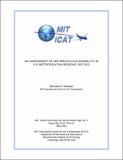An Assessment of Air Service Accessibility in U.S. Metropolitan Regions, 2007-2012
Author(s)
Wittman, M.D.
DownloadICAT-2014-02.pdf (2.164Mb)
Metadata
Show full item recordAbstract
Regional accessibility to air transportation is often of interest to airport executives, politicians, and the general public due to the positive economic impacts of frequent commercial airline service. However, measuring access to air service can be challenging, particularly for regions with multiple airports. While many models exist to measure airline network connectivity at individual airports, there is limited literature on the geographic aggregation of these metrics to assess regional accessibility.
In this paper, we propose a new methodology to construct U.S. regional airport catchment areas using U.S. Census Bureau Primary Statistical Areas (PSAs). Using a connectivity index that evaluates airports on the quantity and quality of available service, air service accessibility scores are computed on a regional level for 323 PSAs from 2007-2012. We find that most U.S. regions lost access to air service during the study period in the midst of domestic schedule rationalization and airline “capacity discipline.” Accessibility scores for each PSA from 2007 to 2012 are available in an appendix.
On average, metropolitan regions in the United States lost about 11.6% of their accessibility to commercial air transportation between 2007 and 2012. Mid-sized regions of 500,000 - 5 million people lost the most access to air service—about 14.4% on average—aligning with past work that suggests that medium-sized communities have been harmed most by airline capacity discipline. In multi-airport regions, losses in service at primary airports outweighed some consolidation in service at larger hubs, leading to net losses in accessibility in most cases.
The results of the accessibility model can be used by regional planners, policy-makers, and airport officials to understand how various regions in the U.S. lost or gained access to air transportation as a result of the Great Recession and airline capacity strategies. Additionally, the proposed catchment area definition provides a useful framework for further discussion of the demographic and geographic determinants of successful commercial air service.
Date issued
2014-05-20Series/Report no.
ICAT;2014-02
Keywords
multi-airport regions, airport catchment areas, regional airports, air transportation